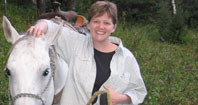
Courtney and gas-free transport
The countryside is more vulnerable to disaster than the big cities, unless you are off-grid, but it is preparing more proactively, according to a new study from the University of Illinois of the differences in how rural and urban citizens across the U.S. respond to disaster. Although rural residents may be more directly involved in responding to crisis, their isolated location can make them more vulnerable and therefore more interested in training. In off-grid communities, however, the situation is reversed.
Courtney Flint, a rural sociologist and assistant professor at the U of I, and her student, Joanne Rinaldi, interviewed 20 coordinators of Community Emergency Response Teams (CERTs) across Illinois to find out what they are doing, what disasters they are prepared for and what they do between disasters.
“What we’ve learned so far is that in rural communities there is a tradition of being more self-reliant,” said Flint. “That makes them check on each other more, but they are also uniquely situated, closer in some ways to the physical environment and more isolated, making them uniquely vulnerable.”
In most cases, disasters are as much a function of social vulnerability as they are some external force – either of nature or technology. When you have a strong capacity to work together among people who share a common place, they are better equiped to take action in times of need. There are lots of other factors involved too, such as communication systems, provisions, access and logistics, etc. and this can vary dramatically within both rural and urban settings.
Flint would say that off-grid communities who are that way by choice and have consciously developed working systems are probably quite prepared to weather emergencies. But it is partly to do with rural poverty. Those who are off-grid by circumstances of socioeconomics or distance (i.e. not by choice) may not have that added capacity.
Perhaps it’s that vulnerability that makes rural communities more self-reliant. Flint said that people in farm communities say, “We’re on our own. We know we’re not going to get the same first response in an emergency as the cities.” While people in urban communities ask questions about liability, rural dwellers say, “We can’t wait around for funding. If we need bandages, we’ll just start ripping up old bed sheets.
�In general, I’d say that those who are used to caring for themselves, their neighbors, families and communities in general and everyday life are more likely to be better prepared for times of disaster. But of course, that depends on the nature of the disaster,� Said Flint.
“Farm families have to keep going,” said Flint. “They may have livestock. They can’t wait for someone to flip the switch. They are more prepared for disaster. They have generators, kerosene heaters, snow plows and other equipment.”
Tornadoes, flooding, winter storms, and hazardous material accidents can strike a city as well as a farm. But in urban communities they are faced with a heavier concentration of people and a social vulnerability – neighbors don’t talk to each other as much.
Flint and Rinaldi are discovering that in rural communities, the CERTs themselves plan as if they might be the first responders to a disaster, while in urban and suburban communities in Chicago, for example, the need for CERTs is different because those communities have extensive first responders in their police and fire departments. “In the Chicago suburbs, the CERTs might do more crowd and traffic control, provide information, answer telephones and work to unite blocks and neighborhoods in a disaster situation,” said Flint.
Most CERTS take an all-hazards approach – that is, they practice responding to a range of potential emergencies. Many of the CERT coordinators spoke about three broad categories of potential hazards: weather events, transportation accidents and hazardous materials, and terrorism.
“After 9/11, one county in Colorado did a big effort on anti-terrorism, but in 2006, they began shifting the focus to fire, flooding and flu because they saw the likelihood for these occurring as much greater,” said Flint.
Before 9/11 there were only about 175 CERTs. Between 2001 and 2006, the number grew to a current listing of 2435. CERTS were moved from being under the Federal Emergency Management Association (FEMA) to Citizen Corps which is under the Department of Homeland Security. There are 86 Citizen Corps groups listed in Illinois but the total number of CERTs in the state is harder to assess. Finding this complete set of CERTs, and assessing how active each one is, is part of the study.
One aspect of Flint’s study is also to look at what CERTs can do between disasters. “We tend to be more reactive than proactive; we wait for the first big freeze to go out to buy shovels, flares for the car and plastic to cover windows,” said Flint. “Before disaster strikes, CERTS can do a lot in a community to be proactive by building awareness, educating and training. In rural communities, they may do work such as stabilizing stream banks that may overflow – that sort of thing.” Defining the role of CERTs and the relationship with other first responders is critical to effective programs. “Funding consistency or a lack of sufficient funds was a common issue for a majority of the CERTs,” said Rinaldi.
Flint hopes that the study will help show policy-makers that one size doesn’t fit all – that urban and rural needs are different. She has a colleague in Florida working on a similar study. Flint wants to develop a national database of active CERTs and to share lessons learned across the state and country between CERTs.